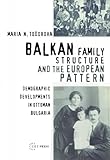Balkan Family Structure and the European Pattern : Demographic Developments in Ottoman Bulgaria / Maria N. Todorova.
Material type: TextPublisher: Budapest ; New York : Central European University Press, [2022]Copyright date: ©2006Description: 1 online resource (252 p.)Content type:
TextPublisher: Budapest ; New York : Central European University Press, [2022]Copyright date: ©2006Description: 1 online resource (252 p.)Content type: - 9786155053863
- 304.6094977 22
- HB3627 .T634 2006eb
- online - DeGruyter
| Item type | Current library | Call number | URL | Status | Notes | Barcode | |
|---|---|---|---|---|---|---|---|
 eBook
eBook
|
Biblioteca "Angelicum" Pont. Univ. S.Tommaso d'Aquino Nuvola online | online - DeGruyter (Browse shelf(Opens below)) | Online access | Not for loan (Accesso limitato) | Accesso per gli utenti autorizzati / Access for authorized users | (dgr)9786155053863 |
Browsing Biblioteca "Angelicum" Pont. Univ. S.Tommaso d'Aquino shelves, Shelving location: Nuvola online Close shelf browser (Hides shelf browser)

|

|

|

|

|

|

|
||
| online - DeGruyter Against Their Will : The History and Geography of Forced Migrations in the USSR / | online - DeGruyter Late Enlightenment : Emergence of the Modern 'National Idea' / | online - DeGruyter Ideologies and National Identities : The Case of Twentieth-Century Southeastern Europe / | online - DeGruyter Balkan Family Structure and the European Pattern : Demographic Developments in Ottoman Bulgaria / | online - DeGruyter The Demise of Yugoslavia : A Political Memoir / | online - DeGruyter Constitutional Democracy / | online - DeGruyter Shifting Obsessions : Three Essays on the Politics of Anticorruption / |
Frontmatter -- TABLE OF CONTENTS -- List of Tables and Figures -- Preface to the Second Edition -- Acknowledgements -- I. INTRODUCTION -- II. POPULATION STRUCTURE -- III. MARRIAGE AND NUPTIALITY -- IV. BIRTH AND FERTILITY -- V. DEATH AND MORTALITY -- VI. FAMILY AND HOUSEHOLD SIZE AND STRUCTURE -- VII. THE PROBLEM OF THE SOUTH SLAV ZADRUGA -- VIII. CONCLUSION -- APPENDICES -- Bibliography -- Index
restricted access online access with authorization star
http://purl.org/coar/access_right/c_16ec
This study, which is an updated, extended, and revised version of the out-of-print 1993 edition, reassesses the traditional stereotype of the place of the Balkans in the model of the European family in the nineteenth century on the basis of new source material and by synthesizing existing research. The work first analyzes family structure and demographic variables as they appear in population registers and other sources, and the impact of these findings on theoretical syntheses of the European family pattern. On most features, such as population structure, marriage and nuptiality, birth and fertility, death and mortality rates, family and household size and structure, as well as inheritance patterns, the Balkans show an enormous deal of internal variety. This variability is put in a comparative European context by matching the quantifiable results with comparable figures and patterns in other parts of Europe. The second section of the book is a contribution to the long-standing debate over the zadruga, the complex, collective, joint or extended family in the Balkans. Finally, the book considers ideology and mythology and the ways it has adversely affected scholarship on the family, and broadly on population history.
Mode of access: Internet via World Wide Web.
In English.
Description based on online resource; title from PDF title page (publisher's Web site, viewed 29. Jul 2022)


